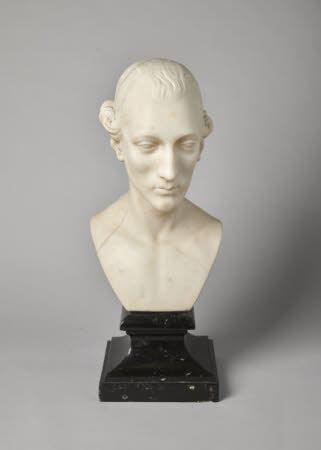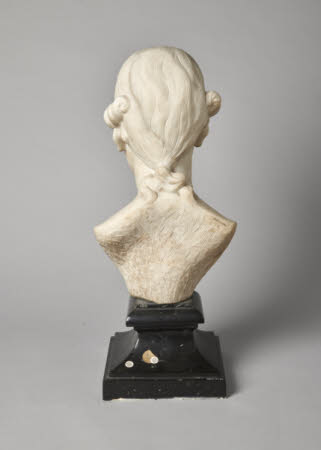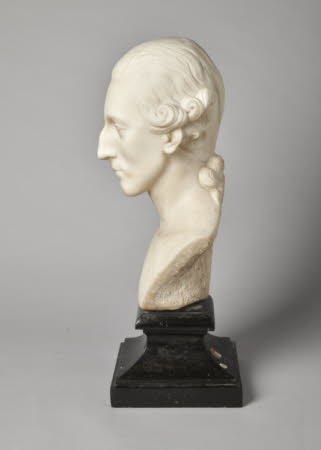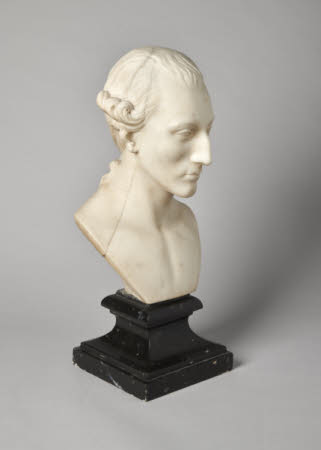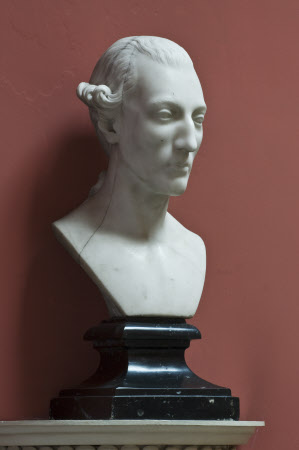Portrait bust of Alexander Stewart of Ards (1746-1831)
attributed to Giovanni Antonio Cybei (Carrara 1706 - Carrara 1784)
Category
Art / Sculpture
Date
circa 1773
Materials
Carrara marble
Measurements
533 mm (H); 254 mm (W); 242 mm (D)
Place of origin
Carrara
Order this imageCollection
Mount Stewart, County Down
NT 1221031
Summary
Sculpture, marble; portrait bust of Alexander Stewart of Ards (1746-1831); attributed to Giovanni Antonio Cybei (1706-1784); c. 1773. One of a pair of extraordinarily refined marble portrait busts depicting the two brothers Alexander Stewart and Robert Stewart, later 1st Marquess of Londonderry (NT 1221032). The portraits may be attributed to the Carrarese sculptor Giovanni Antonio Cybei, who sculpted a series of remarkable portraits in the 1770s. .
Full description
A marble portrait bust depicting Alexander Stewart of Ards (1746-1831), showing the sitter facing forwards, the head set upon a herm-shaped bust section. His hair is carefully arranged into curls at the sides and tied with a ribbon bow at the back. The back is gone over roughly with a claw tool. Upon a black marble rectangular tapering socle. There is a crack running from the right shoulder up into the head. A companion to the portrait bust of Robert Stewart, later 1st Marquess of Londonderry (NT 1221032). Alexander Stewart was the younger son of Alexander Stewart (1699-1781) M.P. of Mount Stewart, and his wife Mary Cowan. The elder Alexander made a fortune in the linen industry whilst his wife Mary was the sister of Sir Robert Cowan, who had become wealthy as governor of Bombay. The younger Alexander grew up at Mount Stewart, but after the death of his father he bought the Ards house and estate in Co. Donegal. In 1791 he married Mary Moore (1772-1842), daughter of the 1st marquess of Drogheda and granddaughter of the 1st Marquess of Hertford, with whom he had three children. Stewart sat as a member of Parliament in the Irish Parliament and then, after the 1801 Act of Union, from 1814-18 as an M.P. in the British House of Commons. The bust is an extraordinary likeness of an individual, with Stewart’s naturally somewhat narrow face projecting a severe, somewhat cold demeanour, partly offset by the liveliness of the springing curls at the sides of his head. The portrait is strongly neo-classical in spirit and style, showing awareness of earlier pioneering neo-classical portrait sculptures such as Joseph Wilton’s bust of Antonio Cocchi, made in Florence in 1755 (Victoria & Albert Museum). The bust and its companion cannot be understood without the fine Grand Tour portraits of the two brothers at Mount Stewart, that of Robert by Anton Raphael Mengs (NT 1220974) and the portrait of Alexander by Pompeo Girolamo Batoni (NT 1220993). Despite their similarity, these portraits contain a mystery, since they were painted fifteen years apart from each other, the Mengs around 1758 and the Batoni in 1773. The Batoni is clearly intended to complement the earlier painting, being the same size and same pose, and also depicting the sitter in ‘van Dyck’ dress, which by the 1770s had become unfashionable. These painted portraits, and the two marble busts, which are neither signed nor dated, are the only evidence currently known that either of the Stewart brothers ever made a Grand Tour to Italy. The Batoni portrait clearly shows the same person as in this marble bust, which must therefore represent Alexander Stewart. The second marble bust seems no less clearly to be identifiable as Robert Stewart, seven years older than his brother, who would therefore have been around 44 in 1773, when the Batoni portrait was painted in Rome and, presumably, his portrait bust was sculpted by Cybei. It seems probable therefore that the two brothers made together a visit to the Continent around 1773, which would have been the second trip to Italy for Robert. A journey at this time would for Robert Stewart have come between the death of his first wife, Lady Sarah Seymour-Conway, in 1770, and his second marriage, to Lady Frances Pratt, in 1775, so might have been undertaken as a solace for grief. One anomaly in the two busts should be noted. They have entirely different socles, which is strange in two portraits supposedly made at the same time and as pendants for one another. It is a possibility that each brother did indeed make just the one Grand Tour, fifteen years apart. The two busts would then stand in the same relationship to each other as the Mengs and Batoni portraits, Alexander Stewart commissioning his marble bust in around 1773, to complement that of his brother, made around 1758. Overall this does nevertheless seem improbable, since the facture of the two busts is similar, and Robert unquestionably seems to be older in the marble bust than the young man depicted by Mengs in 1758. The portraits are not signed, but seem very likely to be the work of the Carrarese sculptor Giovanni Antonio Cybei (1706-1784), who in fact rarely signed his sculptures. Cybei made a number of outstanding portraits, in particular during the early 1770s, when the busts at Mount Stewart were almost certainly made. Born in Carrara, as a young man he went to Rome to work in the studio of the sculptor Agostino Cornacchini. On his return to Carrara he worked for his uncle Giovanni di Isidoro Baratta, assisting him with projects in Turin and elsewhere, but also making his own independent sculptures. After his uncle’s death in 1747, Cybei set up his own workshop. In 1739 he had taken Holy Orders, intending to give up his profession, but subsequently he changed his mind. He became very successful, with his statues and ornamental sculptures sent all over Europe as far as Russia, where a number survive. In 1769 Cybei was appointed the first director of the new Accademia in Carrara, and he also became effectively the court sculptor to the Este family, dukes of Modena, for whom he made a colossal equestrian statue of Francesco III d’Este, destroyed by the French in 1796. He came to be especially noted as a portrait sculptor, the best of bis portraits, made during the period c. 1770-76, showing Cybei moving towards neoclassicism. The crisp modelling and decisive characterisation in the portraits of the Stewart brothers finds many parallels in Cybei’s sculpted portraits, such as the terracotta bust of Maria Teresa Cybo d’Este of 1774 (Carrara, Accademia di Belle Arti; Simone and Massari 2021, pp. 19 and 79, no. 17) or the marble busts of Ludovico Antonio Muratori of 1774 (Biblioteca Estense Universitaria, Modena; Simone and Massari 2021, p. 55) and Bernardo Tanucci, from 1776 (Reggia Caserta; Simone and Massari 2021, pp. 22-23). All these works share the subtle handling of the textures of flesh and the distinctive marking of the eyebrows seen in the Mount Stewart busts. The handling of the hair is closely comparable to that in Cybei’s bust of Pietro Leopoldo of Habsburg-Lorraine, Grand Duke of Tuscany, of which two versions survive: one of 1771 in Pisa, Museo Nazionale di Palazzo Reale (Simone and Massari 2021, p. 88, no. 43); the second, made in 1773, in the Victoria and Albert Museum (Pope-Hennessy 1964, no. 684, fig. 681;Pratesi 1993, II, Pl. 127). Similar virtuoso handling of curls to the bust of Alexander Stewart may be seen in a portrait of Leopoldo II of Habsburg-Lorraine, formerly with the Heim Gallery (Pratesi 1993,II, Pl. 126). Although his remarkable portrait busts of Pompeo Neri and Giovanni Bonaventura Neri Badia of 1771 (Ferrara, Fondazione Cavallini Sgarbi; Simone and Massari 2021, p. 84, nos. 27-28) demonstrate the sculptor’s considerable originality in the field of portraiture, the austerity of the Mount Stewart busts has no parallels in any of Cybei’s other known sculpted portraits. Two other Grand Tour busts by him are however known, charming portraits in a private collection of a small boy and girl dated 1763, with an as yet unidentified coat-of-arms on the socle of the bust of the boy (Simone and Massari 2021, pp. 45, 87-88, nos. 41-42). Jeremy Warren September 2022
Provenance
Lady Mairi Bury (1921-2009), by whom given to the National Trust, in 1976
Makers and roles
attributed to Giovanni Antonio Cybei (Carrara 1706 - Carrara 1784), sculptor Italian School, sculptor
References
Pope-Hennessy 1964: John Pope-Hennessy, Catalogue of Italian Sculpture in the Victoria & Albert Museum, 3 vols., London 1964 Pratesi 1993: Giovanni Pratesi, Repertorio della Scultura Fiorentina del seicento e settecento, 3 vols., Turin 1993 Simone and Massari 2021: Gerardo de Simone and Luciano Massari, eds., Giovanni Antonio Cybei e il suo tempo, exh. cat., Carrara 2021 Ciampolini 2021: Marco Ciampolini, ed., Goya, Boucher, Ricci, Batoni e i maestri del ‘700 nelle citta del Cybei, exh. cat., Museo Carmi, Carrara 2021
